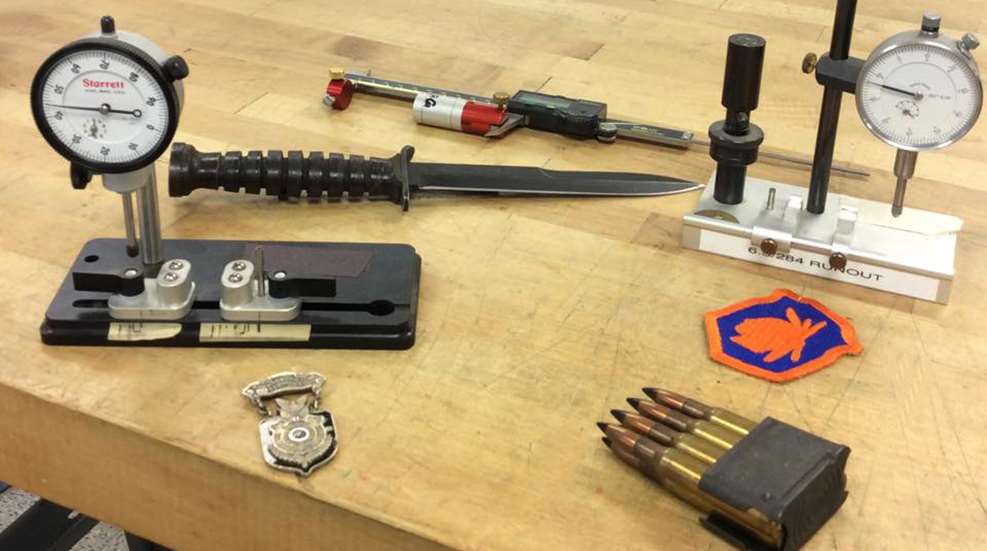
WARNING: All technical data in this publication, especially for handloading, reflect the limited experience of individuals using specific tools, products, equipment and components under specific conditions and circumstances not necessarily reported in the article and over which the National Rifle Association (NRA) has no control. The data has not otherwise been tested or verified by the NRA. The NRA, its agents, officers and employees accept no responsibility for the results obtained by persons using such data and disclaim all liability for any consequential injuries or damages.
Today we’ll address some measurements used in precision handloading, and the benefits of periodic quality control checks. One handloading motto that addresses this principle is: I don’t know what I think, I know what I measure.
Many accuracy-oriented handloaders work hard to minimize seated-bullet runout (a.k.a. Total Indicated Runout, TIR or concentricity). The straighter the cartridge, the better chance the bullet has of entering the rifling well-centered. When 50,000 PSI slams the bullet into the rifling, it deforms to fit. When it does, if the center of gravity is thrown “off” due to bullet distortion, an error is introduced, affecting accuracy.
As measuring tools have become more precise, advanced and available, handloaders have learned to detect and eliminate even small deviations in TIR. However, with the assumed precision implied by modern dial indicators, one must avoid a certain temptation—i.e., there may be lots of space between individual 0.001 inch increments on one’s dial, but if it’s a 0.001 inch calibrated tool, that’s the finest measurement it can reliably produce. It may be tempting to assign a value of 0.0018 inch, say, or 0.0013 inch due to the needle’s position, but reality is that if it measures to 0.001 inch, that IS the maximum level of accuracy.
Another maxim is useful here: just because one CAN measure something, doesn’t necessarily mean that it affects accuracy in a meaningful way. TIR errors might be readily detectable on target using a tight-neck chambered 6PPC steered by a master at 300 yards in flat-calm conditions. However, the same concentricity error may be much harder to reliably detect on target with even a well-built high power match bolt gun, and virtually impossible to see when shooting a service rifle.
Many factors combine to affect accuracy and some, such as bedding, bullet quality or poor load development, may be much more powerful than the effect of TIR in any given instance.
Thus, while it is certainly good to minimize TIR, this writer suggests taking a systems-oriented approach through careful selection and adjustment of reloading dies, brass, etc. Once done, if one reloads consistently, TIR need not occupy more time than a periodic check to ensure the system is still working, or that a new lot of brass has not induced runout, etc.
Active high power shooters fire thousands of rounds in a single season; thus, this is infinitely less labor-intensive than sorting all cartridges individually for runout. Time and energy are resources for the competitive handloader, just as powder, primers and bullets are—and they are not infinite. To produce the best result—i.e., the highest score—one must allocate them consciously and wisely.
Measuring TIR across the handloading process can, however, be very educational, especially for beginning rifle handloaders. One learns many things. One might be that brass from Maker A gives three times the runout of ammo loaded using brass from Maker B. Another is that ammo loaded in new brass with excellent dies is very likely to have more runout than ammo loaded in the same brass after it’s been fired in a good chamber.
Excess neck tension can lead to dramatic increases in TIR. This can occur even with dies that would seemingly render high runout impossible, such as Wilson-type straight-line seater dies. As one sees valid, numerical indicators of their precision, one gains confidence in the consistently high quality of their ammunition.
One can even verify, as this writer has, that a carefully-adjusted set of good, standard hunting dies can produce less runout than an expensive “Match” set, depending on the exact dies used. Or, one can gauge the exact reduction in TIR due to use of individual match-grade dies (i.e., just the seater or just the size die) vs. their standard counterparts.
Learning about TIR and how to minimize it not only helps one produce consistently high-quality ammunition. It can also verify the value of one’s investment in more expensive dies, or detect processes gone awry.
This discussion is not intended to prompt beginning handloaders to spend all their free time minimizing runout. Rather, it is intended to put the importance of TIR into perspective, given one’s discipline and rifle, and to help newer shooters avoid wasting time better spent elsewhere.
Highly-concentric ammunition is always good, but it is only one of many areas of endeavor. One must focus on the areas that will give the most improvement per time/energy invested. Very often, those are practice and dry-fire!
SSUSA thanks the U.S. Army Marksmanship Unit for allowing the reprint of this article.


































